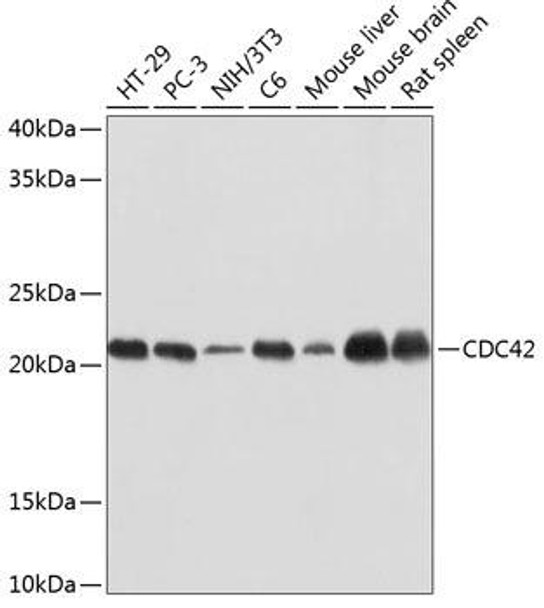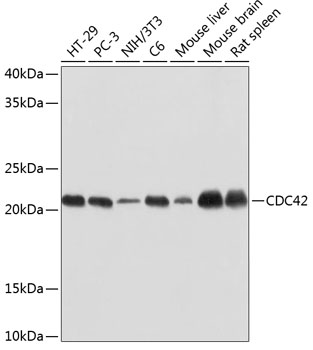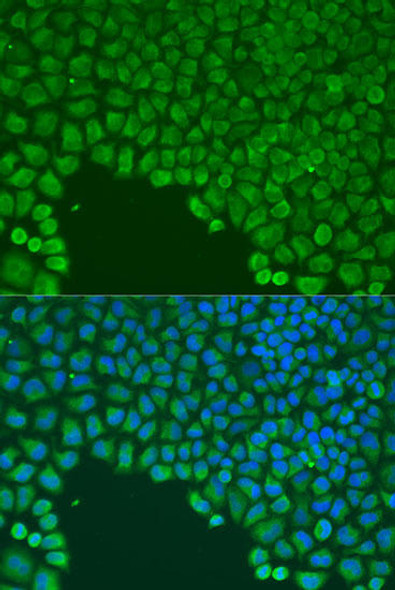| Synonyms: | CDC42, CDC42Hs, G25K, TKS |
| Background: | The protein encoded by this gene is a small GTPase of the Rho-subfamily, which regulates signaling pathways that control diverse cellular functions including cell morphology, migration, endocytosis and cell cycle progression. This protein is highly similar to Saccharomyces cerevisiae Cdc 42, and is able to complement the yeast cdc42-1 mutant. The product of oncogene Dbl was reported to specifically catalyze the dissociation of GDP from this protein. This protein could regulate actin polymerization through its direct binding to Neural Wiskott-Aldrich syndrome protein (N-WASP), which subsequently activates Arp2/3 complex. Alternative splicing of this gene results in multiple transcript variants. Pseudogenes of this gene have been identified on chromosomes 3, 4, 5, 7, 8 and 20. [provided by RefSeq, Apr 2013] |
| UniProt Protein Function: | Plasma membrane-associated small GTPase which cycles between an active GTP-bound and an inactive GDP-bound state. In active state binds to a variety of effector proteins to regulate cellular responses. Involved in epithelial cell polarization processes. Regulates the bipolar attachment of spindle microtubules to kinetochores before chromosome congression in metaphase. Plays a role in the extension and maintenance of the formation of thin, actin-rich surface projections called filopodia. Mediates CDC42-dependent cell migration. |
| NCBI Summary: | The protein encoded by this gene is a small GTPase of the Rho-subfamily, which regulates signaling pathways that control diverse cellular functions including cell morphology, migration, endocytosis and cell cycle progression. This protein is highly similar to Saccharomyces cerevisiae Cdc 42, and is able to complement the yeast cdc42-1 mutant. The product of oncogene Dbl was reported to specifically catalyze the dissociation of GDP from this protein. This protein could regulate actin polymerization through its direct binding to Neural Wiskott-Aldrich syndrome protein (N-WASP), which subsequently activates Arp2/3 complex. Alternative splicing of this gene results in multiple transcript variants. Pseudogenes of this gene have been identified on chromosomes 3, 4, 5, 7, 8 and 20. [provided by RefSeq, Apr 2013] |
| UniProt Code: | P60953 |
| NCBI GenInfo Identifier: | 322510015 |
| NCBI Gene ID: | 998 |
| NCBI Accession: | P60953.2 |
| UniProt Secondary Accession: | P60953,P21181, P25763, Q7L8R5, Q9UDI2, |
| UniProt Related Accession: | P60953 |
| Molecular Weight: | 191 |
| NCBI Full Name: | Cell division control protein 42 homolog |
| NCBI Synonym Full Names: | cell division cycle 42 |
| NCBI Official Symbol: | CDC42 |
| NCBI Official Synonym Symbols: | G25K; CDC42Hs |
| NCBI Protein Information: | cell division control protein 42 homolog; G25K GTP-binding protein; GTP-binding protein, 25kD; growth-regulating protein; GTP binding protein, 25kDa; small GTP binding protein CDC42; dJ224A6.1.1 (cell division cycle 42 (GTP-binding protein, 25kD)); dJ224A6.1.2 (cell division cycle 42 (GTP-binding protein, 25kD)) |
| UniProt Protein Name: | Cell division control protein 42 homolog |
| UniProt Synonym Protein Names: | G25K GTP-binding protein |
| Protein Family: | Cdc42 |
| UniProt Gene Name: | CDC42 |
| UniProt Entry Name: | CDC42_HUMAN |







